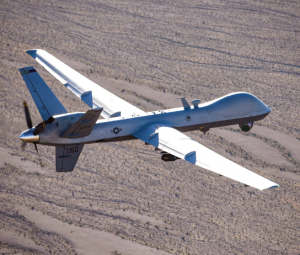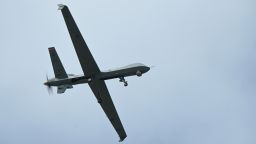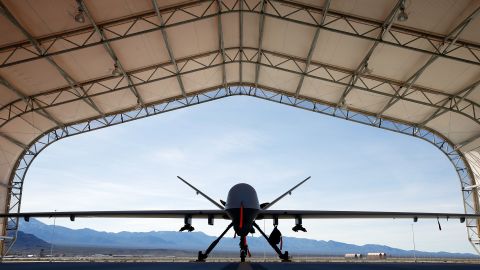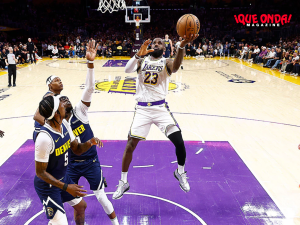 The US has released footage of the moment a Russian plane dumped fuel on a US drone over the Black Sea on Tuesday – a confrontation that has sparked a diplomatic spat and led to a race to recover some highly classified technology.
The US has released footage of the moment a Russian plane dumped fuel on a US drone over the Black Sea on Tuesday – a confrontation that has sparked a diplomatic spat and led to a race to recover some highly classified technology.
The White House slammed Moscow’s actions as “unsafe, unprofessional and reckless” while Russia’s defense ministry denied its aircraft came into contact with the drone.
But dramatic footage that was declassified on Thursday seemingly shows the Russian jet emitting a plume of fuel over the drone, causing its camera systems to cut off.
Russian and US aircraft have operated over the Black Sea during Moscow’s war in Ukraine, but this is the first incident of its kind since the conflict began – and it threatens to heighten tensions between the two countries further.
Here’s what you need to know.
What happened to the US drone?
The drone – a US-made MQ-9 Reaper – and two Russian Su-27 aircraft were flying over international waters over the Black Sea on Tuesday when one of the Russian jets intentionally flew in front of and dumped fuel on the unmanned aerial vehicle several times, a statement from US European Command said.
The aircraft then hit the propeller of the drone, prompting the drone’s remote operators to bring the MQ-9 drone down in international waters. Pentagon spokesman Brig. Gen. Patrick Ryder added Tuesday that the Russian aircraft flew “in the vicinity” of the drone for 30 to 40 minutes before colliding just after 7 a.m. Central European Time.
The Russians had given a different version of events. A Russian fighter aircraft “did not use airborne weapons or come into contact” with a US Air Force MQ-9 Reaper drone over the Black Sea, the Russian defense ministry said in a statement Tuesday.

Russian fighter jet forces down US drone over Black Sea
Thursday’s video provides a view from the drone’s cameras of the interaction, showing the Russian jet veering closely over the unmanned aerial vehicles (UAV).
“It clearly demonstrated our narrative of what happened and I think if any of you have seen that video you can see clearly that it does,” said John Kirby, the strategic communications coordinator at the National Security Council.
He said the decision to release the footage was in part to “lay bare and to make clear to the rest of the world the manner in which the Russians have been just flat out lying, flat out lied, about their account” of the episode.
Who will recover the downed drone?
The incident marks the first known time Russian and US military aircraft have come into direct physical contact since Russia launched its invasion of Ukraine just over a year ago and is likely to increase tensions between the two nations.
More pressingly, a race is underway to avoid the drone falling into the wrong hands.
The Russian Security Council Secretary said Wednesday that Russia may try to get the wreckage of the drone to study it.
“I don’t know if we will be able to get it or not, but we need to do it… And we will definitely look into it,” said Nikolai Patrushev on on Russian state TV Rossiya 1.
On Thursday, Ukraine’s Operational Command said Russia is increasing its presence in the Black Sea with a “rather atypical number of ships,” in a post on its official Facebook page.
“The rather atypical number of ships in the amount of 21 units may also be related to a demonstration of dominance at sea,” following Tuesday’s drone incident, Operational Command “South” said.
“It is also possible that the Russians themselves will conduct a search operation,” it said.
What is the MQ-9 Reaper drone?
The US Air Force primarily uses the Reaper for collecting intel, according to the service’s website, which touts the “intelligence, surveillance and reconnaissance” abilities of the drone.
But when armed, the drone can also be used against “high-value, fleeting, and time-sensitive” executive targets, given its weapons systems and its ability to surveil an area for a long period of time.
In other words, the Reaper is both capable of surveilling and striking an enemy. These dual uses have earned the Reaper a nickname in military circles: the “hunter-killer.”
The US Air Force has relied heavily on drones for a number of missions; it had logged more than 2 million cumulative flight hours by 2019, according to the Department of Defense’s most recent unclassified Selected Acquisition Report (SAR), and was flown for around 330,000 hours each year.
They are expensive; a unit of four aircraft costs $56.5 million, according to the Air Force.
The surveillance and strike platforms saw heavy service in the US-led wars in Iraq and Afghanistan. But the Air Force has been looking to wind down the production and use of the drones in recent years. Annual funding for the program has declined since it reached more than $800 million annually on two occasions during the Obama administration, SARs show.
Following Russia’s invasion of Ukraine last year, Politico reported that the Air Force was looking to send some of its older drones to Kyiv, and was seeking to persuade the Pentagon to approve the move.
Why was the US flying a drone in this region?
American reconnaissance missions have been a regular occurrence in international airspace over the Black Sea for several years, and the area has been heavily militarized since Russia annexed Crimea in 2014, so it is not uncommon for a US drone to be spotted over these waters.
Russia appeared to claim on Tuesday that the area falls under the remit of its invasion of Ukraine, which it euphemistically calls a special military operation; Russian Ambassador to the US Anatoly Antonov said in response to a question from CNN that Russia “had informed about this space that was identified as a zone for special military operation.”

“We have warned not to enter, not to penetrate,” he said, asking how the US would react if a Russian drone came close to New York or San Francisco – a continuation of Russia’s claim that it is entitled to Ukrainian land.
But that argument carries little weight outside of Moscow, given Russia’s annexation of Ukrainian territory in Crimea in 2014 and then its unprovoked full-scale invasion of the entire country last year.
The US has said that the drone was in fact flying over international waters when it was downed; interactions between Russian and US operations in that region happen frequently, and it’s unclear whether Moscow intended to down the drone or whether it was simply trying to “buzz” the aircraft – a close fly-by that is done to encourage the drone or plane to move on.
Has this happened before?
The US has repeatedly reprimanded Russia for buzzing its aircraft in the Black Sea in recent years.
Around 90% of US reconnaissance flights over the Black Sea, often flown out of nearby naval stations in Europe, are intercepted by Russian jets, according to the US military in 2020.
Russia has been sending some US-provided weapons captured in Ukraine to Iran, sources say
“The greatest risk is miscalculation. The Russians do intercept these aircraft frequently,” Capt. Tim Thompson, commodore of the US Navy’s Task Force 67, told CNN that year. “They tend to be very professional and safe, but, on occasion, they can be unprofessional.”
And this is not the first Reaper to be downed while on a mission. In 2019 the US blamed Iran for the shooting down of a MQ-9 Reaper over Yemen by a surface-to-air missile.
Dara Massicot, a senior policy researcher at the RAND Corporation who specializes on defense issues relating to Russia, wrote on Twitter that Tuesday’s incident “fits with a larger pattern” by Russia of “escalating signals before coming too close to a platform,” though she noted that dumping fuel on the drone appeared to be a new tactic.
Massicot described the incident as “a close pass that went bad,” and suggested that it followed a Russian approach of “(escalating) behavior to compel their target to change course.”
What happens next?
Despite the history of encounters in the Black Sea, Russia’s ongoing invasion of Ukraine heightens has heightened tensions in the region. The US European Command said in its press release on Tuesday that the incident “could lead to miscalculation and unintended escalation.”
US National Security Council communications coordinator John Kirby called the incident unique in how “unsafe, unprofessional and reckless” the Russian actions were; Antonov said that Russia did not want “confrontation” with the US.
After Tuesday’s harsh language and the summoning of the Russian ambassador in DC, the US took the rare step of hastily declassifying and releasing footage from the drone – directly calling out Russia’s version of events.
That step could escalate the war of words over the incident.
But there is a pressing question that remains unanswered: what will become of the downed Reaper and its highly classified payload? According to the NSC’s Kirby, the US is not confident it will be able to successfully find wreckage in the Black Sea.
“I’m not sure we are going to be able to recover it,” he told CNN This Morning.
Russia has signaled its intention to find the wreckage first. And Moscow’s Navy has several ships in the Black Sea, including ships based in Crimean ports, which would have placed them in an advantageous position to attempt to recover the US MQ-9 Reaper drone after its encounter with Russian fighter jets on Tuesday.
The drone came down in international waters in the Black Sea approximately 70 miles southwest of Crimea, one of the officials said. It is unclear if Russia was able to recover any of the wreckage from the drone when they arrived at the crash site.










